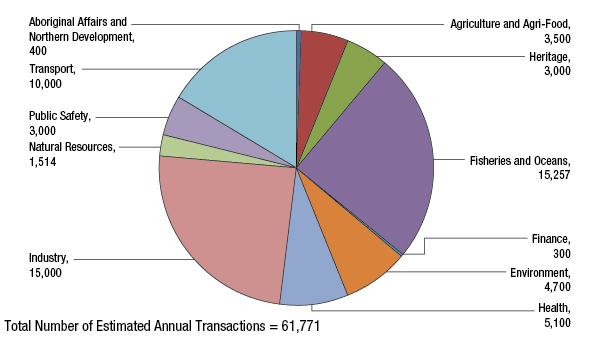The 2012–2013 Scorecard Report: Implementing the Red Tape Reduction Action Plan
Archived information
Archived information is provided for reference, research or recordkeeping purposes. It is not subject à to the Government of Canada Web Standards and has not been altered or updated since it was archived. Please contact us to request a format other than those available.
6. Service standards for high-volume regulatory authorizations
“[The Government] will establish service standards and complaint processes for high-volume regulatory authorizations. This will give stakeholders a clear opportunity to provide feedback on the service they receive.”
Government of Canada, Red Tape Reduction Action Plan, 2012
6.1 Our commitment
Canadians and businesses expect quality and predictability in the services they receive from government. While regulation itself is not a service, it is legitimate to expect that regulatory activities be managed with a strong service orientation and a clear commitment to service performance. These activities are called regulatory authorizations. Through its regulatory authorizations, the Government of Canada grants an individual, business or regulated entity permission either to conduct a regulated activity or to be exempt from it. For businesses, clear and timely regulatory decisions can impact their ability to operate, grow and expand.
Service standards are a public commitment to provide a measurable level of service that clients can expect to receive under normal circumstances. They help clarify expectations for clients by indicating how long they should expect to wait once a service has been accessed. Through the Red Tape Reduction Action Plan, the Government committed to developing and reporting annually on service standards for all high-volume regulatory authorizations where service standards either do not exist or are not publicly available.
A high-volume regulatory authorization is defined as “one with 100 or more transactions per year.”
- TBS’s Guide on Improving Service Performance for Regulatory Authorizations
Regulators have until March 2016 to publicly release service standards for all of their high-volume regulatory authorizations that impact business. By March 1, 2013, regulators were required to publish their first set of service standards for all of their high-volume regulatory authorizations that have 2,000 or more transactions per year, or, if they do not have any of these, their next highest volume regulatory authorization. Regulators were to make these service standards public using their Acts and Regulations Web pages.
Starting in June 2014, regulators will be required to report performance against all of their publicly available service standards for high-volume regulatory authorizations on an annual basis.
6.2 Summary of results: 2012–2013
In spring 2013, regulators made clear progress toward filling the service standards gap. Overall, regulators posted service standards for 24 high-volume regulatory authorizations and processes on their Acts and Regulations Web pages, 19 of which had service standards posted that were either brand new or never before reported publicly. See footnote [6]
Overview of service standards for high-volume regulatory authorizations
The 19 newly available service standards cover a wide range of high-volume regulatory authorizations and processes that impact business, such as the issuance of:
- lands-related permits on Indian lands;
- radio operator certificates;
- overweight vehicle permits for certain designated national park areas; and
- permits for the import and export of controlled substances.
As a result of the federal regulatory community’s efforts in this area, more than 60,000 annual regulatory transactions (or “touch points”) with business have been added to those that are already governed by a publicly available timeliness commitment, performance target and service feedback mechanism (see Graph 6.1). This represents an important first step towards improving service performance within the federal regulatory system.
Graph 6.1: Estimated Number of Annual Transactions for High-Volume Regulatory Authorizations and Processes with Newly Available Service Standards by Portfolio See endnote 5 *

Return to endnote reference 5 * Based on departmental estimates of annual transactions for high-volume regulatory authorizations and processes with new service standards posted in spring 2013.
For each service standard (or the associated regulatory authorization), regulators must provide basic information to ensure a transparent and predictable service experience for stakeholders, including:
- how long an applicant should expect to wait to receive a decision for a regulatory authorization;
- the performance target for meeting service standards;
- the performance achieved against these targets (starting in June 2014);
- the information requirements and process that applicants must follow when applying for the authorization; and
- the service feedback mechanism for lodging a complaint if service expectations have not been met.
TBS assessed all newly available service standards for high-volume regulatory authorizations and processes required by March 1, 2013, against these requirements. In addition, TBS communicated the results of these assessments to regulators so that they could make any necessary improvements to their service standards.
Through these assessments, TBS observed that all regulators had met these requirements. Of note, three regulators (Canadian Heritage, the Canadian Nuclear Safety Commission and the Public Health Agency of Canada) published performance against their service standards for previous fiscal years. However, TBS also observed that, in some instances, regulators need to be clearer in describing the information requirements and processes associated with their regulatory authorizations. This will assist stakeholders (especially individuals and small businesses) when applying to conduct a regulated activity. It should also be noted that, as service performance is reported and experience builds, regulators will have the opportunity to revisit their service standards and performance targets to ensure continuous improvement in the delivery of their regulatory services.
- Date modified: